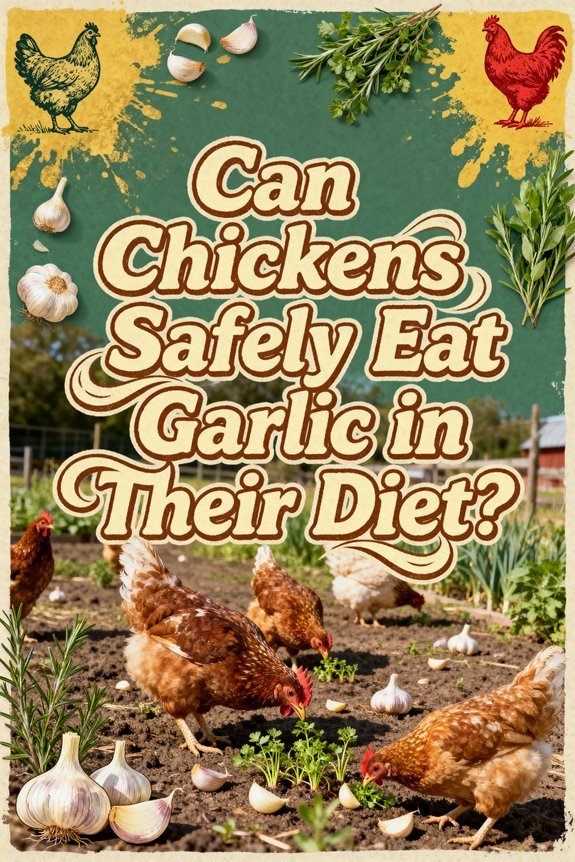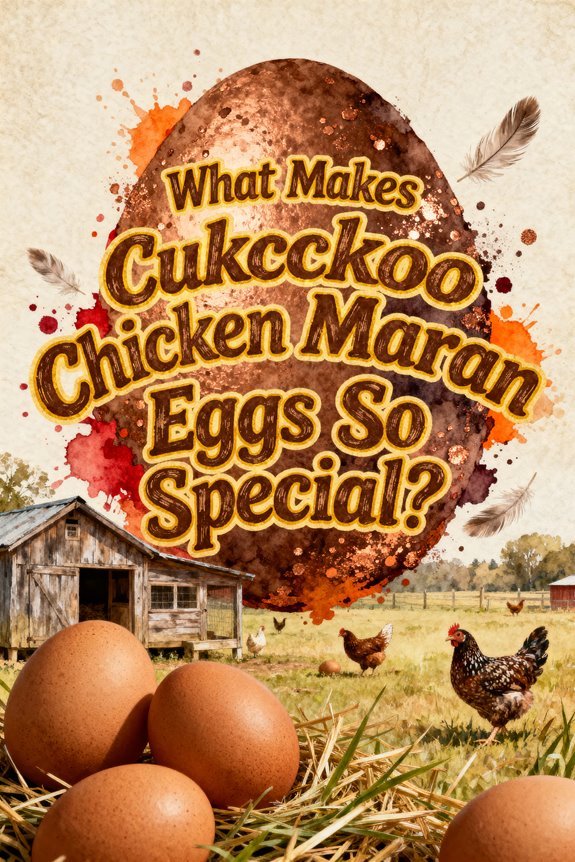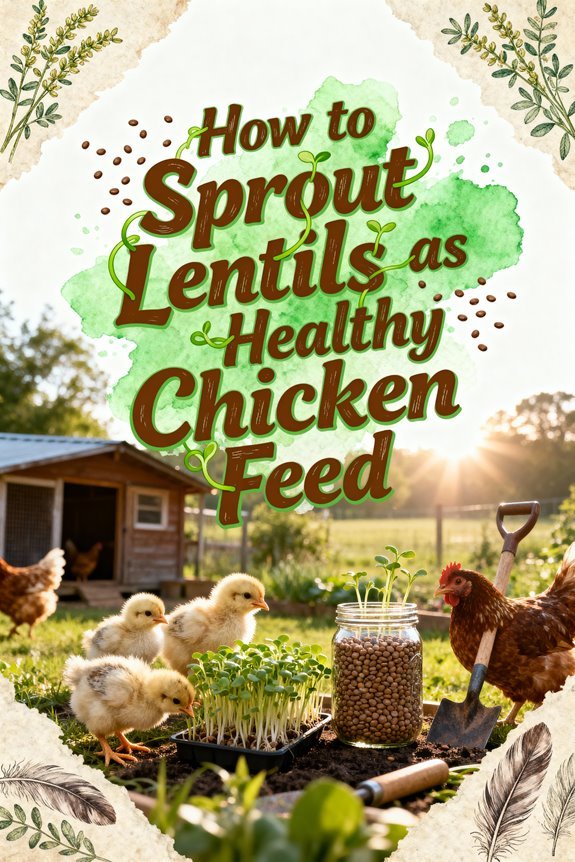Can Chickens Safely Eat Raw and Cooked Potatoes?
Raw potatoes contain toxic glycoalkaloids that can seriously harm your chickens, causing symptoms like vomiting, diarrhea, and even paralysis. You’ll need to thoroughly cook any potatoes before feeding them to your flock, and always remove green spots and sprouts which contain the highest toxin levels. Serve cooked potatoes only as an occasional treat, limiting treats to 2-3 servings weekly. Sweet potatoes offer a safer, more nutritious alternative with none of the toxic risks – and there’s much more to know about keeping your chickens safe.
Understanding Potato Toxicity in Chickens
While chickens can safely eat cooked potatoes, raw potatoes pose a significant health risk due to toxic compounds called glycoalkaloids, primarily solanine and chaconine. These potato alkaloids effects range from digestive disturbances to severe neurological symptoms. When your chickens consume raw potatoes, especially green ones, they may experience vomiting, diarrhea, and poor nutrient absorption. Sweet potatoes are a safer alternative. The toxicity threshold varies, but exposure to these compounds can lead to dizziness, paralysis, and respiratory difficulties in your flock. Unlike free-range ducks, confined chickens may be more likely to eat toxic items due to boredom. Solanine interferes with cellular respiration and disrupts nerve function, causing weakness and impaired muscle control. The highest concentrations of these toxins occur in green parts of the tuber, sprouts, and potato foliage. You’ll need to be particularly vigilant about keeping these parts away from your chickens, as severe poisoning can result in death.
The Dangers of Green and Sprouted Potatoes
Green and sprouted potatoes present a severe health hazard to chickens due to their high concentrations of glycoalkaloids, particularly solanine and chaconine. These toxins concentrate heavily in potato skins, eyes, and green portions, with sprouted potatoes being especially dangerous due to elevated toxin levels at the sprout base.
You’ll find the highest toxin concentrations in the green parts and sprouts, which can cause severe digestive tract inflammation, ulceration, and abdominal edema in your chickens. While chickens naturally avoid green potatoes due to their bitter taste, they may still encounter toxic potato materials while grazing. To protect your flock, you must remove all green potatoes, sprouts, and volunteer potato plants from their environment. Never feed your chickens any potatoes showing signs of greening or sprouting, as even small amounts can trigger poisoning. Instead, focus on providing your chickens with properly cooked potatoes which are both safe and nutritious for your flock.
Safe Preparation Methods for Potato Feeding
To safely feed potatoes to chickens, proper preparation methods are essential for eliminating harmful toxins and preventing potential poisoning. Your primary potato preparation technique should be baking at high temperatures, as this effectively destroys solanine toxins in the peels. Don’t rely on boiling, which is less effective at toxin removal. Green potato peels indicate dangerously high levels of solanine and must never be fed to chickens.
When implementing cooking techniques, you’ll need to thoroughly cook all potato scraps before feeding. Never serve raw potatoes to your flock. Even with proper cooking, you must remove any green spots or sprouted areas, as these parts remain toxic despite heat treatment. Keep portions modest and use potato scraps only as occasional treats, not as a primary feed source. Like white bread treats, potatoes offer minimal nutritional value and should be limited in their diet. Just as with citrus fruits, moderation is key to prevent digestive issues in your chickens. Always inspect potatoes for freshness and avoid any showing signs of spoilage or discoloration.
Sweet Potatoes: A Superior Alternative
Unlike standard potatoes, sweet potatoes offer superior nutritional benefits for your chickens without the risks of solanine toxicity. These nutritious tubers contain 90% digestible carbohydrates and essential vitamins A, B, C, and E that support immune function and overall health. Studies show that cooking increases digestibility and reduces harmful trypsin inhibitors found in raw sweet potatoes. Similar to fresh shrimp shells, sweet potato peels can provide beneficial nutrients when properly prepared. While chickens serve as disease sentinels in mosquito control programs, they still need proper nutrition for optimal health.
For ideal sweet potato benefits, incorporate them into your flock’s diet as either oven-dried or cooked forms, which provide better nutrient utilization than raw preparations. Following proper feeding guidelines, you can replace up to 30% of maize with sweet potato in your chickens’ feed for best results. The leaves and vines also serve as valuable supplements, providing antioxidants and helping prevent behavioral issues. You’ll notice improved egg quality, including enhanced yolk color and stronger shells, while potentially reducing your feed costs through this economical alternative.
Recognizing Signs of Potato Poisoning
Since potato poisoning can quickly become lethal in chickens, recognizing early warning signs is essential for immediate intervention. The first symptoms typically emerge within 8-12 hours of ingestion, though they can appear in as little as 10 minutes with high doses. Watch for sudden behavioral changes like depression, weakness, and reduced feed intake. Members of the nightshade family plants are particularly toxic to chickens and should be avoided entirely. Similar to toxic persin, these substances can be fatal to chickens if consumed.
Key symptom recognition includes gastrointestinal distress, particularly diarrhea and vomiting. You’ll notice neurological effects such as incoordination, tremors, and dilated pupils. In severe cases, your chickens may show signs of paralysis or collapse. Exposure to potatoes with glycoalkaloid compounds can disrupt the intestinal barrier and cause inflammatory responses. Check your environment for potential exposure sources like green potatoes, sprouts, or peelings in the coop or compost. These symptoms can mimic other conditions, so consider recent access to potato materials when evaluating affected birds.
Best Practices for Feeding Potatoes
After understanding how to spot potato poisoning, proper feeding methods become the next line of defense. When feeding potato varieties to your chickens, always choose sweet potatoes over white, red, or yellow varieties due to their superior safety and nutritional profile. Cook all potatoes thoroughly at temperatures above 400°F to reduce toxin levels, and cool them completely before serving. A well-designed coop with proper ventilation helps maintain food freshness and prevents moisture-related issues with treats.
Monitor your feeding portions carefully by offering potatoes as treats rather than dietary staples. You’ll want to combine these treats with other vegetables and grains for balanced nutrition. Since solanine toxicity can be dangerous, never feed potato peels unless you’re certain they’re free from green spots or mold. If you’re using sweet potatoes, you can safely include their leaves and vines, which provide additional nutrients for your flock.
Debunking Common Potato Feeding Myths
When it comes to feeding potatoes to chickens, several persistent myths cloud the facts about safety and toxicity. One common potato misconception is that all potatoes are unsafe for chickens, regardless of preparation. In reality, only raw and green potatoes contain dangerous levels of solanine, while properly cooked potatoes are safe to feed. Consuming raw potato peels can cause serious symptoms including dizziness and arrhythmia. Just as automatic waterers provide consistent hydration for chickens, establishing safe feeding practices is essential for flock health. Even gentle breeds like the Porcelain d’Uccle require careful attention to toxic food prevention.
Another widespread myth suggests that potato peels are always toxic. This isn’t true – cooked peels pose no risk to your flock. Solanine awareness is essential when you hear claims that chickens can safely consume small amounts of raw potato. Even minimal quantities of raw potato can cause serious health issues, and there’s no evidence that chickens develop tolerance to these toxins. Don’t be misled by anecdotal reports of chickens surviving raw potato consumption – the risks aren’t worth taking.
Nutritional Value and Feeding Guidelines
Understanding potato nutrition helps maximize their benefits in your chickens’ diet while maintaining safety. Potatoes provide 77 kcal per 100 grams and contain essential nutrients like vitamin B3, folate, and lutein that support cellular health and bone maintenance. While white potatoes offer these potato benefits, sweet potatoes deliver higher vitamin content, particularly vitamin A. Chickens can safely consume 2-3 weekly servings as treats. If your neighbor’s chickens frequently enter your property to eat your potato garden, work to resolve the issue through peaceful negotiations rather than taking matters into your own hands. Unlike white potatoes, sweet potato skins are completely safe and nutritious for chickens to eat.
Feeding moderation is vital for both varieties. You’ll need to cook white potatoes to reduce solanine content and enhance nutrient availability. Sweet potatoes, being solanine-free, can be served raw when properly cut into manageable pieces. Incorporate either type as treats rather than main feed components. For ideal results, serve boiled, baked, or mashed potatoes without seasoning, and always avoid green or sprouted specimens that could harm your flock.
Safe Alternatives From the Vegetable Garden
Your vegetable garden offers numerous safe and nutritious alternatives to potatoes for feeding chickens. Leafy greens like kale and Swiss chard provide essential minerals and vitamins, while romaine lettuce offers hydration without the concerns associated with raw potatoes. For ideal chicken health, you’ll find excellent options in root vegetables such as carrots and sweet potatoes, which deliver beta carotene and fiber safely. Bell peppers, cucumbers, and zucchini contribute crucial nutrients while encouraging natural pecking behaviors. Unlike their usual egg laying cycle of one egg per day, healthy hens occasionally produce two eggs within 24 hours, though this is extremely rare. Pumpkins and winter squash varieties serve as particularly valuable garden vegetables during colder months, supporting immune function and gut health. Offering fermented grains alongside vegetables can improve nutrient absorption and digestive health in chickens. When selecting from these alternatives, you’ll need to maintain proper portion control and always verify they complement, rather than replace, your chickens’ primary feed. Using raised bed gardens helps protect your vegetable crops while still allowing controlled chicken access during appropriate times.




